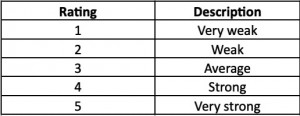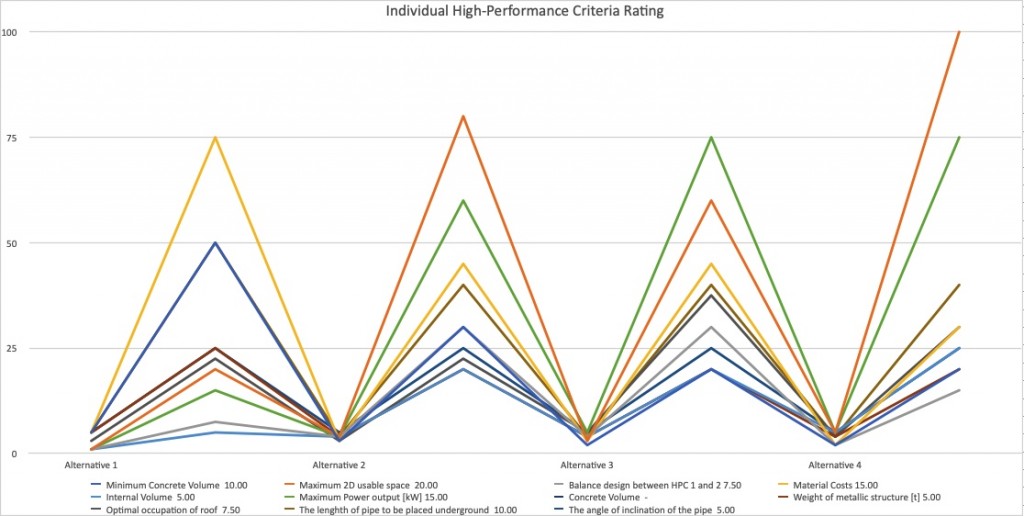At the end of each configuration, there is one main question that needs to be answered: “Which of the generated alternatives best fits the customer’s wishes and the set goals?”
To find the right answer to this question, the high-performance criteria set on the basis of the customer’s wishes are considered. In order to be able to evaluate the individual high-performance criteria based on the integrated design variants, a rating concept must be created. For this purpose, the ten different high-performance criteria were scaled in terms of their importance for the integrated model. In the process, 100% was allocated to the high-performance criteria according to their importance. To arrive at the overall performance of the individual alternatives, the rating is multiplied by the unweighted score for each high-performance criterion. Finally, the weighted ratings are summed for each alternative. Based on this distribution, the four alternatives were evaluated individually with regard to the achievement of the criterion. The range is from 1 (very weak) to 5 (very strong) and is described more in detail in the following table:

It is important to note that this rating is based on the expertise of the designer team and may therefore be somewhat subjective. The following table provides an overview of all high-performance criteria and their ratings for the different design variants:

Based on the rating system, it is possible to reach 500% per alternative, but this is unlikely due to the multiple high-performance criteria. However, when looking at table 6, it is shown which of the alternatives performs best in percentage terms. Here it is clear that alternative 4 performs best in terms of the individual high-performance criteria with 380%. This is mainly due to the fact that this alternative best fulfills the highly rated high-performance criteria “Maximum 2D usable space” and achieves the maximum rating of 100%. However, it is also apparent that the criteria relating to costs (“Minimum Concrete Volume” and “Material Costs”) perform rather poorly in comparison. Furthermore, alternatives 2 and 3 score equally well with 372.50 %. This is due to the fact that these alternatives are well balanced in terms of high-performance criteria and are therefore only slightly below the 380 % of design alternative 4 in percentage terms. In particular, the individual high-performance criteria of the Photovoltiak and Pipe systems are fulfilled above average. In terms of costs, alternatives 2 and 3 are closer to alternative 4, while alternative 1 performs better in percentage terms. Looking at the evaluation of alternative 1 in more detail, it is noticeable that the cost factors score best here but this is related to their poor performance in many of the remaining criteria (for example, in the important criteria “Maximum 2D usable space” or “Internal Volume”, which can have a negative impact on efficiency).

Looking at the above figure, the results of the rating of the individual HPC with regard to the four different alternatives are visualized in the peaks of the diagram. Here, each high-performance criterion is assigned a color (see legend). The y axis shows the total maximum weighted rating achieved for the respective high-performance criteria for each of the four alternatives (the four alternatives are shown on the x axis). The visualization confirms above all the finding that design alternatives 2 and 3 are best balanced. Also, the findings that alternative 1 is the least expensive and alternative 4 has the maximum 2D usable space and power output is confirmed by looking at the diagram.